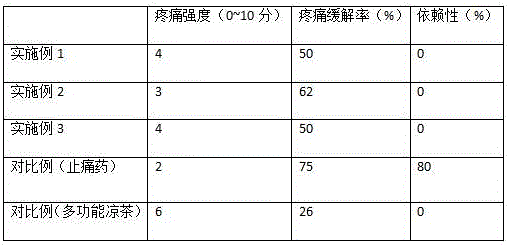Herb tea for relieving pain and preparation method of herb tea
A technology of herbal tea and fresh tea leaves, which is applied in the field of herbal tea and its preparation, and can solve the problems of poor efficacy and lack of single function of herbal tea
- Summary
- Abstract
- Description
- Claims
- Application Information
AI Technical Summary
Problems solved by technology
Method used
Image
Examples
Embodiment 1
[0024] Embodiment 1: the preparation method of the herbal tea that is used for relieving pain, comprises the following steps:
[0025] Step 1. Prepare 10 parts of Radix Paeoniae Rubra, 5 parts of Forsythia leaves, 5 parts of Gynostemma, 5 parts of Artemisia argyi leaves, 1 part of Chuanqiong, 1 part of Jigucao and 20 parts of fresh tea leaves. Among them, Radix Paeoniae Rubra, Chuanqiong and Chicken Bones Grass is the processed rhizome medicinal material, and the leaves of the other Chinese medicinal materials Forsythia, Gynostemma and Artemisia argyi are selected. The red peony, Chuanqiong and Jigucao are mixed together to form group A, and the forsythia, Gynostemma and Artemisiae Mixed with fresh tea leaves to form group B;
[0026] Step 2. Soak group A for 1-5 days, decoct and filter, and concentrate the obtained concoction until it becomes a thick paste; wither, kill and ferment the mixed leaves of group B to obtain a crude product for later use ;
[0027] Step 3. Mix th...
Embodiment 2
[0029] Embodiment 2: the preparation method of the herbal tea that is used for pain relief, comprises the following steps:
[0030] Step 1. Prepare 12 parts of Radix Paeoniae Rubra, 7 parts of Forsythia leaves, 8 parts of Gynostemma, 7 parts of Artemisia argyi leaves, 2 parts of Chuanqiong, 2 parts of Jigucao and 25 parts of fresh tea leaves. Among them, Radix Paeoniae Rubra, Chuanqiong and Chicken Bones Grass is the processed rhizome medicinal material, and the leaves of the other Chinese medicinal materials Forsythia, Gynostemma and Artemisia argyi are selected. The red peony, Chuanqiong and Jigucao are mixed together to form group A, and the forsythia, Gynostemma and Artemisiae Mixed with fresh tea leaves to form group B;
[0031] Step 2. Soak group A for 1-5 days, decoct and filter, and concentrate the obtained concoction until it becomes a thick paste; wither, kill and ferment the mixed leaves of group B to obtain a crude product for later use ;
[0032] Step 3. Mix the...
Embodiment 3
[0034] Embodiment 3: the preparation method of the herbal tea that is used for pain relief, comprises the following steps:
[0035] Step 1. Prepare 15 parts of Radix Paeoniae Rubra, 8 parts of Forsythia leaves, 10 parts of Gynostemma, 8 parts of Artemisia argyi leaves, 3 parts of Chuanqiong, 3 parts of Jigucao and 30 parts of fresh tea leaves. Among them, Radix Paeoniae Rubra, Chuanqiong and Chicken Bones Grass is the processed rhizome medicinal material, and the leaves of the other Chinese medicinal materials Forsythia, Gynostemma and Artemisia argyi are selected. The red peony, Chuanqiong and Jigucao are mixed together to form group A, and the forsythia, Gynostemma and Artemisiae Mixed with fresh tea leaves to form group B;
[0036] Step 2. Soak group A for 1-5 days, decoct and filter, and concentrate the obtained concoction until it becomes a thick paste; wither, kill and ferment the mixed leaves of group B to obtain a crude product for later use ;
[0037] Step 3. Mix th...
PUM
 Login to View More
Login to View More Abstract
Description
Claims
Application Information
 Login to View More
Login to View More - R&D
- Intellectual Property
- Life Sciences
- Materials
- Tech Scout
- Unparalleled Data Quality
- Higher Quality Content
- 60% Fewer Hallucinations
Browse by: Latest US Patents, China's latest patents, Technical Efficacy Thesaurus, Application Domain, Technology Topic, Popular Technical Reports.
© 2025 PatSnap. All rights reserved.Legal|Privacy policy|Modern Slavery Act Transparency Statement|Sitemap|About US| Contact US: help@patsnap.com

